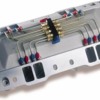On my stroker 408 there’s no system for ventilating the crankcase besides filters on both valve covers. That means oil fumes and a little oil leaking onto the engine. I want to create a vacuum, like the PCV system most cars have, to avoid fumes and oil dilation. And I’ve even heard that this vacuum makes the rings seat better, creating power.
The simple remedy is of course a PCV system, but I don’t like them, they lean out the carb at varying degrees depending on vacuum, and as they become clogged, you have no idea what can happen to your A/F ratio.
I’ve considered a Crankcase Evacuation System like this:
http://www.summitracing.com/parts/MIL-85700/
It looks simple enough, and I’ve often seen it on dragrace engines etc., but hardly ever on a street car. It does say “crankcase evacuation systems are designed for drag race use only.”
Does anybody use it? Does it do what it’s supposed to? Why do you need 2, having just one and fresh air sucked in at the other valve cover would ventilate better than 2 vacuums?
Thanks
Original Post


